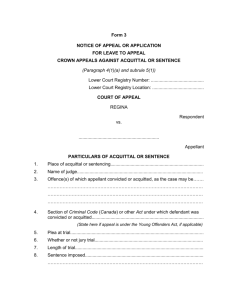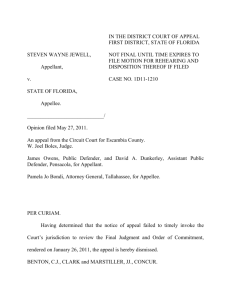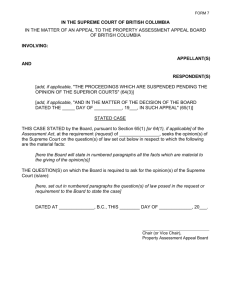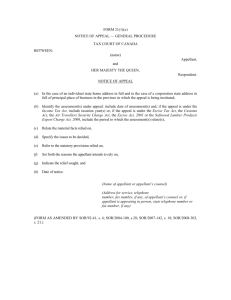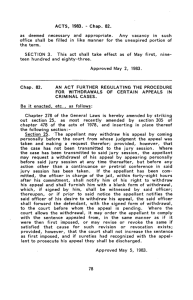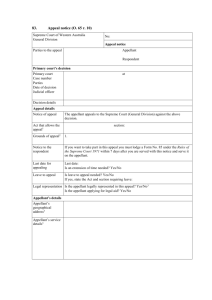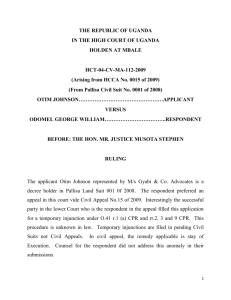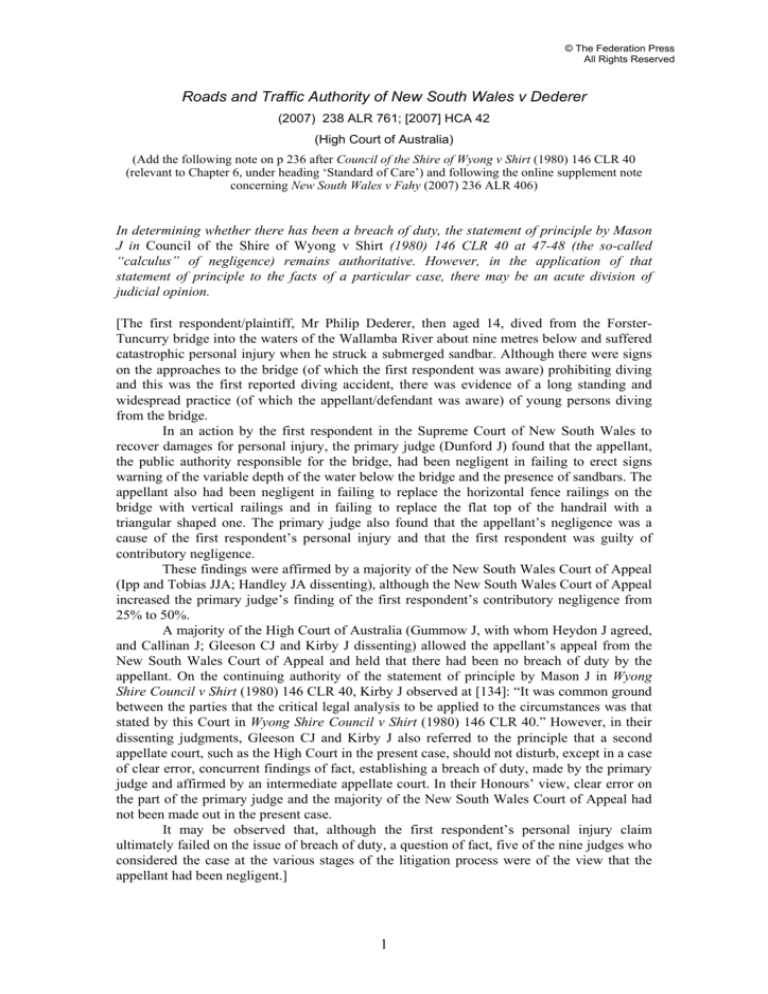
© The Federation Press
All Rights Reserved
Roads and Traffic Authority of New South Wales v Dederer
(2007) 238 ALR 761; [2007] HCA 42
(High Court of Australia)
(Add the following note on p 236 after Council of the Shire of Wyong v Shirt (1980) 146 CLR 40
(relevant to Chapter 6, under heading ‘Standard of Care’) and following the online supplement note
concerning New South Wales v Fahy (2007) 236 ALR 406)
In determining whether there has been a breach of duty, the statement of principle by Mason
J in Council of the Shire of Wyong v Shirt (1980) 146 CLR 40 at 47-48 (the so-called
“calculus” of negligence) remains authoritative. However, in the application of that
statement of principle to the facts of a particular case, there may be an acute division of
judicial opinion.
[The first respondent/plaintiff, Mr Philip Dederer, then aged 14, dived from the ForsterTuncurry bridge into the waters of the Wallamba River about nine metres below and suffered
catastrophic personal injury when he struck a submerged sandbar. Although there were signs
on the approaches to the bridge (of which the first respondent was aware) prohibiting diving
and this was the first reported diving accident, there was evidence of a long standing and
widespread practice (of which the appellant/defendant was aware) of young persons diving
from the bridge.
In an action by the first respondent in the Supreme Court of New South Wales to
recover damages for personal injury, the primary judge (Dunford J) found that the appellant,
the public authority responsible for the bridge, had been negligent in failing to erect signs
warning of the variable depth of the water below the bridge and the presence of sandbars. The
appellant also had been negligent in failing to replace the horizontal fence railings on the
bridge with vertical railings and in failing to replace the flat top of the handrail with a
triangular shaped one. The primary judge also found that the appellant’s negligence was a
cause of the first respondent’s personal injury and that the first respondent was guilty of
contributory negligence.
These findings were affirmed by a majority of the New South Wales Court of Appeal
(Ipp and Tobias JJA; Handley JA dissenting), although the New South Wales Court of Appeal
increased the primary judge’s finding of the first respondent’s contributory negligence from
25% to 50%.
A majority of the High Court of Australia (Gummow J, with whom Heydon J agreed,
and Callinan J; Gleeson CJ and Kirby J dissenting) allowed the appellant’s appeal from the
New South Wales Court of Appeal and held that there had been no breach of duty by the
appellant. On the continuing authority of the statement of principle by Mason J in Wyong
Shire Council v Shirt (1980) 146 CLR 40, Kirby J observed at [134]: “It was common ground
between the parties that the critical legal analysis to be applied to the circumstances was that
stated by this Court in Wyong Shire Council v Shirt (1980) 146 CLR 40.” However, in their
dissenting judgments, Gleeson CJ and Kirby J also referred to the principle that a second
appellate court, such as the High Court in the present case, should not disturb, except in a case
of clear error, concurrent findings of fact, establishing a breach of duty, made by the primary
judge and affirmed by an intermediate appellate court. In their Honours’ view, clear error on
the part of the primary judge and the majority of the New South Wales Court of Appeal had
not been made out in the present case.
It may be observed that, although the first respondent’s personal injury claim
ultimately failed on the issue of breach of duty, a question of fact, five of the nine judges who
considered the case at the various stages of the litigation process were of the view that the
appellant had been negligent.]
1
Roads and Traffic Authority (NSW) v Dederer
© The Federation Press
All Rights Reserved
GUMMOW J. [some footnotes omitted] [779] 65. … Whether reasonable care was exercised in the
particular case is a question of fact going to the breach of any duty owed, not to the existence of that
duty. In each case, the question of whether reasonable care was exercised is to be adjudged
prospectively, and not by retrospectively asking whether the defendant’s actions could have prevented
the plaintiff’s injury. As Hayne J stated in Vairy v Wyong Shire Council (2005) 223 CLR 422 at 461:
When a plaintiff sues for damages alleging personal injury has been caused by the defendant’s
negligence, the inquiry about breach of duty must attempt to identify the reasonable person’s
response to foresight of the risk of occurrence of the injury which the plaintiff suffered. That
inquiry must attempt, after the event, to judge what the reasonable person would have done to
avoid what is now known to have occurred. Although that judgment must be made after the
event it must seek to identify what the response would have been by a person looking forward at
the prospect of the risk of injury. (emphasis omitted)
66. Each of these principles was misapplied by the trial judge and the majority in the Court of
Appeal. As explained earlier in these reasons, their Honours erred by focusing in retrospect on the
failure of the RTA to prevent Mr Dederer’s dive, as opposed to asking what, in prospect, the exercise
of reasonable care would require in response to a foreseeable risk of injury. …
[780] 67. What, then, was the correct approach towards assessing breach? The particular trap
into which the majority of the Court of Appeal fell was that warned against by Hayne J in Vairy (at
462):
If, instead of looking forward, the so-called Shirt calculus is undertaken looking back on what is
known to have happened, the tort of negligence becomes separated from standards of
reasonableness. It becomes separated because, in every case where the cost of taking alleviating
action at the particular place where the plaintiff was injured is markedly less than the
consequences of a risk coming to pass, it is well nigh inevitable that the defendant would be
found to have acted without reasonable care if alleviating action was not taken. …
69. … What Shirt requires is a contextual and balanced assessment of the reasonable response
to a foreseeable risk. Ultimately, the criterion is reasonableness, not some more stringent requirement
of prevention.
70. Here, the risk of injury consequent upon jumping or diving from the bridge into water of
variable depth was reasonably foreseeable. Indeed, the Court of Appeal correctly found, contrary to the
trial judge, that the risk was one that was [781] obvious even to a 14 year old boy, and it beggars belief
that the RTA could not foresee the very conduct against which its signage warned. The RTA’s
evidentiary dispute about whether it did in fact know of the continued practice of diving is beside the
point: reasonable foreseeability is to be determined objectively, and the present risk was plainly
foreseeable on any objective standard.
71. The magnitude of the risk was self-evidently grave. Mr Dederer’s partial paralysis is
among the worst kinds of injuries imaginable. The probability of that injury occurring was, however,
low. Despite the frequency of jumping and diving from the bridge, no-one was injured until Mr
Dederer’s unfortunate dive.
72. What, then, of the expense, difficulty and inconvenience of taking alleviating action? The
erection of further warning signs should not have been expensive, but Mr Dederer provided no
evidence that they would be reasonable. The installation of pool-type fencing and a triangular cap on
the handrail would have been more expensive and intrusive. The estimate of the cost of the handrail
modification was some $108,072, and it was accepted that the cost of new fencing would be around
$150,000 but, again, the reasonableness of such measures is open to doubt. …
[782] 78. Returning, then, to the assessment of breach mandated by Shirt, it becomes apparent
that the RTA did not breach its duty of care. Though grave, the risk faced by Mr Dederer was of a very
low probability, and a reasonable response to that risk did not demand the measures suggested by him.
…
79. This was not a case in which the defendant had done nothing in response to a foreseeable
risk. To the contrary, the RTA had erected signs warning of, and prohibiting, the very conduct engaged
in by Mr Dederer. … In the circumstances, that was a reasonable response, and the law demands no
more and no less. …
80. The appeal should be allowed with costs. The RTA did not breach the duty of care it owed
to Mr Dederer. …
CALLINAN J. [some footnotes omitted] … [824] 271. All parties, as did the courts below, accepted
that the well-known formulation of Mason J in Wyong Shire Council v Shirt (1980) 146 CLR 40 at 4748 should be applied here:
2
Roads and Traffic Authority (NSW) v Dederer
© The Federation Press
All Rights Reserved
In deciding whether there has been a breach of the duty of care the tribunal of fact must first ask
itself whether a reasonable man in the defendant’s position would have foreseen that his conduct
involved a risk of injury to the plaintiff or to a class of persons including the plaintiff. If the
answer be in the affirmative, it is then for the tribunal of fact to determine what a reasonable
man would do by way of response to the risk. The perception of the reasonable man’s response
calls for a consideration of the magnitude of the risk and the degree of the probability of its
occurrence, along with the expense, difficulty and inconvenience of taking alleviating action and
any other conflicting responsibilities which the defendant may have. It is only when these
matters are balanced out that the tribunal of fact can confidently assert what is the standard of
response to be ascribed to the reasonable man placed in the defendant’s position.
[825] 272. The evidence shows that there was a basis for holding that … the appellant …
should reasonably have foreseen that the bridge and the railing on it, in its current state might present
these risks: that the latter might provide a platform for divers and jumpers; and that they might thereby
injure themselves, severely, either by jumping or diving on to a passing boat or a submerged bank, or
indeed in the water itself.
273. The question then becomes, what was an appropriate response to those risks? That has to
be answered by balancing the magnitude of the risk, the degree of probability of its occurrence, and the
expense, difficulty and inconvenience of taking alleviating action, and any other conflicting
responsibilities of the defendants.
274. In my opinion the trial judge and the majority of the Court of Appeal erred, by failing to
undertake this balancing exercise in a sufficient and proper way. Had they done so they would have
identified and given full weight to these matters. As to “magnitude”, I accept that diving from a height
of 8 to 10 metres was itself a risky activity. It was for this reason that it was discouraged by police and
officials, banned, and the subject of the pictograph signs. But even so, and despite flagrant defiance of
the ban, not one out of the many who had dived in the 40 or so years that had elapsed since the
construction of the bridge had been injured, so far as anyone could recall, let alone severely injured.
This is to say that the risk, although undisputedly present, had a very low degree of probability of
realization. And although the first respondent’s injuries were grave, that is of great magnitude,
seemingly minor mishaps can sometimes cause grave injuries.
275. Also to be balanced, are the interests of the community in being able to walk across the
bridge, to enjoy the view, and to pause and lean in comfort on a flat surface of a top rail as they do so.
Only an extremely high unscaleable fence, with perhaps shards of glass embedded in its top, or barbed,
or electric, or razor wire, might, on the evidence, have deterred determined and adventurous youths
from climbing and jumping. Equally, the substitution of vertical bars for horizontal rails is unlikely to
have been an effective deterrent. Other measures such as the provision permanently of a sufficient
number of police or other officials would exceed the requirements of a reasonable response. …
276. In any event, the notion that the first respondent and other youths would have heeded a
worded sign when they flagrantly disregarded a pictograph sign of unmistakeable import, strains
credibility. Indeed, the making of the excruciatingly fine distinctions, as each of the courts below did,
between the content of the signs actually erected, and other allegedly preferable ones, as to which those
courts themselves were not in agreement, was quite unconvincing. …
[826] 278. A defendant is not an insurer. Defendants are not under absolute duties to prevent
injury, or indeed even to take all such measures as might make it less likely to occur. They are obliged
only to make such responses as can be seen to be reasonable in the circumstances. A proper balancing
exercise which takes all of the relevant circumstances into account leads inescapably to the conclusion
that the appellant, in responding to a risk that had not been realized for 40 years, by erecting the
pictograph signs, acted reasonably and adequately. …
282. … I would allow the appeal. …
Appeal allowed
3

